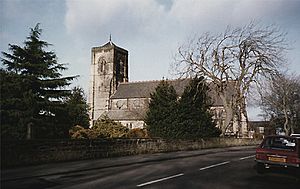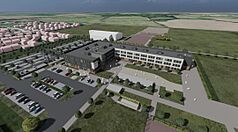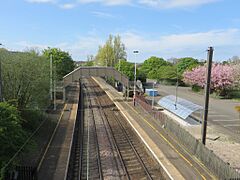Cramlington facts for kids
Quick facts for kids Cramlington |
|
|---|---|
 The parish church of St. Nicholas |
|
| Population | 28,843 (2021 Census ward data) |
| OS grid reference | NZ270760 |
| Civil parish |
|
| Unitary authority |
|
| Ceremonial county | |
| Region | |
| Country | England |
| Sovereign state | United Kingdom |
| Post town | CRAMLINGTON |
| Postcode district | NE23 |
| Dialling code | 01670 |
| Police | Northumbria |
| Fire | Northumberland |
| Ambulance | North East |
| EU Parliament | North East England |
| UK Parliament |
|
Cramlington is a town and civil parish located in Northumberland, England. It is about 6 miles (10 km) north of Newcastle upon Tyne. The town's name suggests it was likely founded by the Danes or Anglo-Saxons a long time ago.
In 2021, the population of Cramlington was 28,843 people. The town sits right on the border between Northumberland and North Tyneside. A major road interchange at Moor Farm, Annitsford, connects these two areas. East Cramlington is a part of the town located east of the A189.
Contents
History of Cramlington
The first time Cramlington was mentioned in official records was in 1135. This was when the land was given to a person named Nicholas de Grenville. Records of early church leaders in Cramlington go all the way back to the 1160s.
For many centuries, Cramlington was mostly a farming area with several farms. It also had the parish church of St. Nicholas, which was built between 1865 and 1868 in the Gothic style. In the early 1800s, coal mining started to change the area. There were several mine shafts nearby. In 1813, an explosion at Collingwood Main Colliery killed 8 people. This happened when candles set fire to gas in the mine.
Cramlington stayed quite small until 1964. That year, it was officially named a New Town. This meant that developers like William Leech and J.T. Bell started building many new housing estates. These new areas were named Beaconhill, Collingwood, Eastfield, Mayfield, Shankhouse, Southfield, and Whitelea. Because of this growth, Cramlington became a dormitory town. This means many people live there but travel to work in the much larger city of Newcastle upon Tyne to the south.
During World War I, the North East of England was protected by the No. 36 Home Defence Squadron. This squadron was formed at Cramlington Aerodrome in 1916. Cramlington then became an important base for military planes and airships. The airship station was located at Nelson Village.
Cramlington was also the site of two train accidents. In 1855, a first-class train carriage broke down. In 1926, the Merry Hampton engine and five carriages of the famous Flying Scotsman express train were derailed. This happened when striking miners caused the derailment during the General Strike.
In 1986, during the BBC Domesday Project, it was recorded that Cramlington's population was around 30,000 people.
How Cramlington Became a New Town
The idea of developing Cramlington as a new town first came up in 1958. In June 1961, the local council approved the first plans. They hoped it would be "Britain's first enterprise town." The council supported the project, and a group of developers led by William Leech bought the land.
It was predicted that the development would take 20 years and cost £50 million. The plan was to build homes for 40,000 people across a four-square-mile area. This area would also include an industrial zone for businesses. The old paths used by coal wagons were planned to be turned into walking paths for people.
The government finally approved the plan in January 1963. By then, the estimated population had grown to 48,000, and the cost was expected to be £60 million. This was special because it was the first time a new town was developed without a government-backed development group. The first factory was planned to be finished by summer 1963.
In 2017, old remains of an Iron Age settlement were found where new houses were planned. Even though many people in the town were interested, the local council decided to continue with building the houses.
Local Government
Cramlington has had different forms of local government over the years. In 1865, the Cramlington Local Government District was created. Later, in 1894, the Cramlington Urban District was formed. This was replaced by the Seaton Valley Urban District in 1935.
From April 1, 1974, Cramlington became part of Blyth Valley. Then, on April 1, 2009, responsibilities were moved to Northumberland County Council.
On September 5, 2019, Cramlington Town Council created the position of Town Mayor to celebrate its 10th anniversary. Cllr Loraine De Simone became the first Town Mayor. She has been a councillor for the Cramlington Village area since 2017.
The most recent local election in 2021 saw the Conservative party win most of the seats on the Northumberland County Council.
The results for the Parish and Town council elections in Cramlington on May 6, 2021, were:
- Cramlington East - Phil and Faith Rudd (Independent) & Elizabeth Mitcheson (Labour)
- Cramlington North - Wayne Daley & Helen Morris (Conservative)
- Cramlington West - Barry Flux & Patricia Heard (Conservative)
- Cramlington Eastfield - Christine Dunbar & Norman Dunbar (Conservative)
- Cramlington South East - Paul Ezhilchelvan & Stephen Garrett (Conservative)
- Cramlington Village - Loraine De Simone & Mark Swinburn (Conservative)
After Cllr Mitcheson passed away in August 2023, a special election was held in the Cramlington East ward on November 16, 2023. Feona Bowey (Labour) won this election.
Housing Areas
When Cramlington was developed as a new town, it was divided into different housing areas, often named after the part of town they were in.
Some of these housing areas include:
- Nelson Village
- High Pit
- Northburn (built in the late 1980s and 1990s)
- Northburn Manor (built in the early 2000s)
- Eastfield (built in the 1970s, with more added in the mid-1990s)
- Westwood (built in the early 1980s)
- Southfield Lea (built in the early 1970s)
- Southfield Gardens (built in the early 2000s)
- Mayfield (some parts existed before the new town, with more built in the late 1960s)
- Whitelea (one of the first new town areas, built in the late 1960s and early 1970s)
- Barns Park (built in the 1970s)
- Parkside (built in the 1970s)
- Beacon Hill (built in the 1970s)
- Beacon Lane (built in the 1970s)
- Collingwood Grange (built in the late 1960s)
- Southfield Lea Westerkirk Extension (built in the 1980s)
- Bassington Manor (built between 2015 and 2017)
- St Nicholas Manor (built between 2017 and 2023)
- Collingwood Chase (built in the late 1960s)
- Southfield Green (built in the early 1970s)
New Housing Developments
Northumberland County Council and other investors have put a lot of money into the south-west part of Cramlington. Plans for this area started in the late 2000s and early 2010s. House builders like Bellway Homes, Persimmon, Barratt, and Keepmoat are working together to develop this area, which is known as Arcot.
The housing areas in this new sector include:
- Arcot Manor (built between 2017 and 2023)
- The Fairways (built between 2017 and 2024)
- Beaconsfield Park (currently being built)
- West Meadows (currently being built)
- Foxton Mill (currently being built)
- Fairway View (currently being built)
Economy and Businesses
Industry
Cramlington has several large industrial areas, mostly in the north-west of the town. These areas are home to major pharmaceutical companies like Merck Sharp and Dohme. Other growing chemical companies, such as Aesica Pharmaceuticals, are also located here. The Officers Club, a menswear company, used to have its main office and warehouse in Cramlington. Other large companies like GE Oil & Gas also have big sites in the town. Start Football also has its main office in Cramlington.
Wilkinson Sword opened the first factory in the town in 1964. American Air Filter Company later built its premises there. Brentford Nylons also opened a large factory in the town in 1968. Boots, the pharmaceutical manufacturer, opened its plant in Cramlington in 1983.
Shopping
The Manor Walks shopping centre was built in the town centre in the 1970s. It was made bigger in the mid-1990s and again in 2003/2004. The centre now has many shops, including Argos, Asda, Boots, Boyes, Next, and Sainsbury's. In 2011, plans were made to update the main centre and build a new cinema. This plan also included better shops, restaurants, cafes, and more car parking spaces.
Healthcare
Northumbria Healthcare NHS Foundation Trust opened the first hospital in England built specifically for emergency care in Cramlington in June 2015. This hospital, called the Northumbria Specialist Emergency Care Hospital, cost £75 million. It has emergency care doctors on duty all the time and many specialists available seven days a week. In February 2021, the NHS trust started legal action against the building contractor, Lendlease, because of problems found in the building's structure.
New Developments
Cramlington Learning Village, the only secondary school in the town and the largest school in the county, is part of the Government’s School Rebuilding Programme. This program involves tearing down the old buildings (built in 1969) and rebuilding them into a new, modern teaching facility.
Plans for this new school campus were first shared in October 2024 by DPP Planning. Construction of the new school began in the summer of 2025 and is expected to be finished by September 2027.
Landmarks and Nature
Plessey Woods Country Park is just north of Cramlington. The River Blyth flows through this country park. Northumberlandia is a huge land sculpture near Cramlington. It is shaped like a reclining female figure. Inside the town, Nelson Hill is a noticeable landmark north of the town centre. Arcot Hall Grasslands and Ponds SSSI is a special nature site south-east of the town.
Transport
Cramlington has its own Cramlington railway station on the East Coast Main Line. You can catch trains to the MetroCentre, Morpeth, and Newcastle upon Tyne. These services are provided by Northern.
The town also has many bus services. Arriva North East provides express buses to Newcastle upon Tyne, Morpeth, and Blyth. Go North East runs services to and from North Shields.
Cramlington is about 12 miles (19 km) from Newcastle International Airport. It is also about 10 miles (16 km) from North Shields International Ferry Terminal.
The town has good road connections, being located between the A1, A19, and A189 roads.
Like many new towns built after World War II in the UK, Cramlington has a large network of cycle paths. These paths are separate from the roads, making it safer for cyclists.
Media
Local news and TV shows for Cramlington are provided by BBC North East and Cumbria and ITV Tyne Tees. TV signals come from the Pontop Pike TV transmitter.
Local radio stations include BBC Radio Newcastle, Heart North East, Capital North East, Smooth North East, Greatest Hits Radio North East, Hits Radio North East, and Koast Radio, which is a community radio station. The local newspaper for the town is the Northumberland Gazette (which used to be called The News Post Leader).
Education
Until September 2008, all schools in Northumberland used a three-tier system (first, middle, and high schools). However, the county decided to change to a two-tier system (primary and secondary schools). Cramlington was one of the first towns to make this change. Before the middle schools closed, some primary schools moved into the old middle school buildings. There were some concerns from local residents about traffic and parking at the new school sites.
Other schools in Cramlington include: Hareside Primary School, Hillcrest School, Shanklea Primary School, Burnside Primary School, Cragside Church of England Primary School, Northburn Primary School, Eastlea Primary School, Beaconhill Primary School, and SS Peter and Paul's Catholic Primary Academy.
Cramlington Learning Village
In September 2008, Cramlington Community High School was renamed Cramlington Learning Village. This was because it added two new year groups as part of the move to the two-tier school system. The school is divided into three sections: the Junior Learning Village (for Years 7 and 8), the Senior Learning Village (for Years 9 to 11), and the Advanced Learning Village (for Years 12 and 13).
The school was rated "outstanding" in four Ofsted inspections in a row. However, in July 2015, this rating was lowered to "inadequate." Then, in February 2017, it was raised to "Good." In July 2022, the school was chosen to be part of the Government's School Rebuilding Programme. This means the old buildings from the 1960s will be rebuilt or greatly improved to create a modern learning space.
Places of Worship
Cramlington has several Christian churches from different denominations:
- Doxford Place Methodist Church
- Welcome Methodist Church (formerly Station Terrace Methodist Church)
- St. Nicholas Parish Church
- St. Andrew's
- St. Peter's
- St. Paul's
Others
- Church of the Nazarene
- Frontline
- Open Episcopal Church
Leisure and Activities
Leisure Centre
Cramlington's main leisure centre, Concordia, is in the town centre next to the shopping mall. It was opened by Queen Elizabeth II in July 1977. It has a swimming pool, which was originally designed to look like an indoor tropical paradise. It also has indoor football pitches, tennis, badminton, and squash courts, as well as a climbing wall. There is also a gym, sauna, bowling green, bar, and cafeteria.
The centre was updated in 2008, especially to make it easier for people with disabilities to use. The pool was also updated in 2011. A major renovation started in 2016, adding new facilities and improving existing ones. Most recently, in 2019, the pool had a big refurbishment. This included replacing the old pool lining and the floor areas around the wet changing rooms and children's water features.
Cycle Paths
A large network of cycle paths, completely separate from the roads, was a key part of the new town's design. There is also a cycle route that connects the town to the nearest beach in Blyth. In March 2007, the local council announced that the cycle network would be extended to connect to the nearby town of Bedlington.
Public Houses
The village square in Cramlington has four public houses, including the Blagdon Arms, which is a Grade II listed building.
Sport
Cramlington Cricket Club (CCC) is based at Cramlington Learning Village. They have two men's senior teams that play in the Northumberland & Tyneside Cricket League, plus two midweek teams. They also have a senior women's team, an academy team, and various junior teams. New players are always welcome.
Cramlington United was started in 2010 and became a Community Club 12 months later. Their home ground is at Northburn Sports & Community Centre. They currently play in the Northern Football Alliance Premier Division.
Arcot Hall Golf Club is located south of the town.
Cramlington Rockets are a Rugby League team based in Cramlington. The club was first formed in 2000 as Killingworth Rockets ARLFC. They play on the fields of the Cramlington Learning Village. Their first team is currently in the North East Division of the Rugby League Conference.
Twin Towns
Cramlington is part of a "town twinning" program with three other towns, as part of the former Blyth Valley borough:
- Since 1994, with Solingen and Ratingen in North Rhine-Westphalia, Germany.
- Since 1991, with Gelendzhik in Krasnodar Krai, Russia.
Famous People from Cramlington
- Charles Fenwick, a trade union leader.
- Sam Heads, an expert in insects and fossils.
- Ross Noble, a comedian.
- Ray Stevenson, an actor.
- Sting, a musician, was a schoolteacher at St Paul's Roman Catholic Voluntary Aided First School from 1974 to 1976.
Football Players
- Joe Brown, a football player in the 1940s and 1950s, and later manager for Burnley.
- James Brown, a striker for Hartlepool United, was born in Cramlington.
- Steven Caldwell, a former Newcastle United defender, Burnley captain, and Scotland international, once lived in Cramlington.
- John Carver, a former footballer and previously assistant manager at Newcastle United.
- Mark Clattenburg, a Premier League referee.
- Peter Haddock, a professional football player who lived in Cramlington. He is best known for playing for Leeds United, and also played for Newcastle United and Burnley.
- Jimmy Isaac, a footballer in the 1930s and 1940s for Huddersfield Town.
- Jamie McClen, a footballer.
- Michael Oliver, the youngest ever Premier League referee, lives in Cramlington.
- Ray Pointer (1936-2016), a footballer for Burnley and England, was born in Cramlington.
- Peter Ramage played youth football for Cramlington Juniors F.C.
- Alan Shearer, played youth football for Cramlington Juniors F.C.
- Andy Sinton, a former footballer for Queens Park Rangers, Sheffield Wednesday, and Spurs.
- Martin Taylor, a professional footballer who played for Sheffield Wednesday; he attended Cramlington High School.
- Steven Taylor played youth football for Cramlington Juniors F.C.
Other Sports People
- Stephen Miller, a Paralympic athlete who won three gold medals, is from Cramlington.
- Gary Robson, a professional darts player.
- Roger Uttley, a former England national Rugby Union player, was a sports teacher at Cramlington High School.




